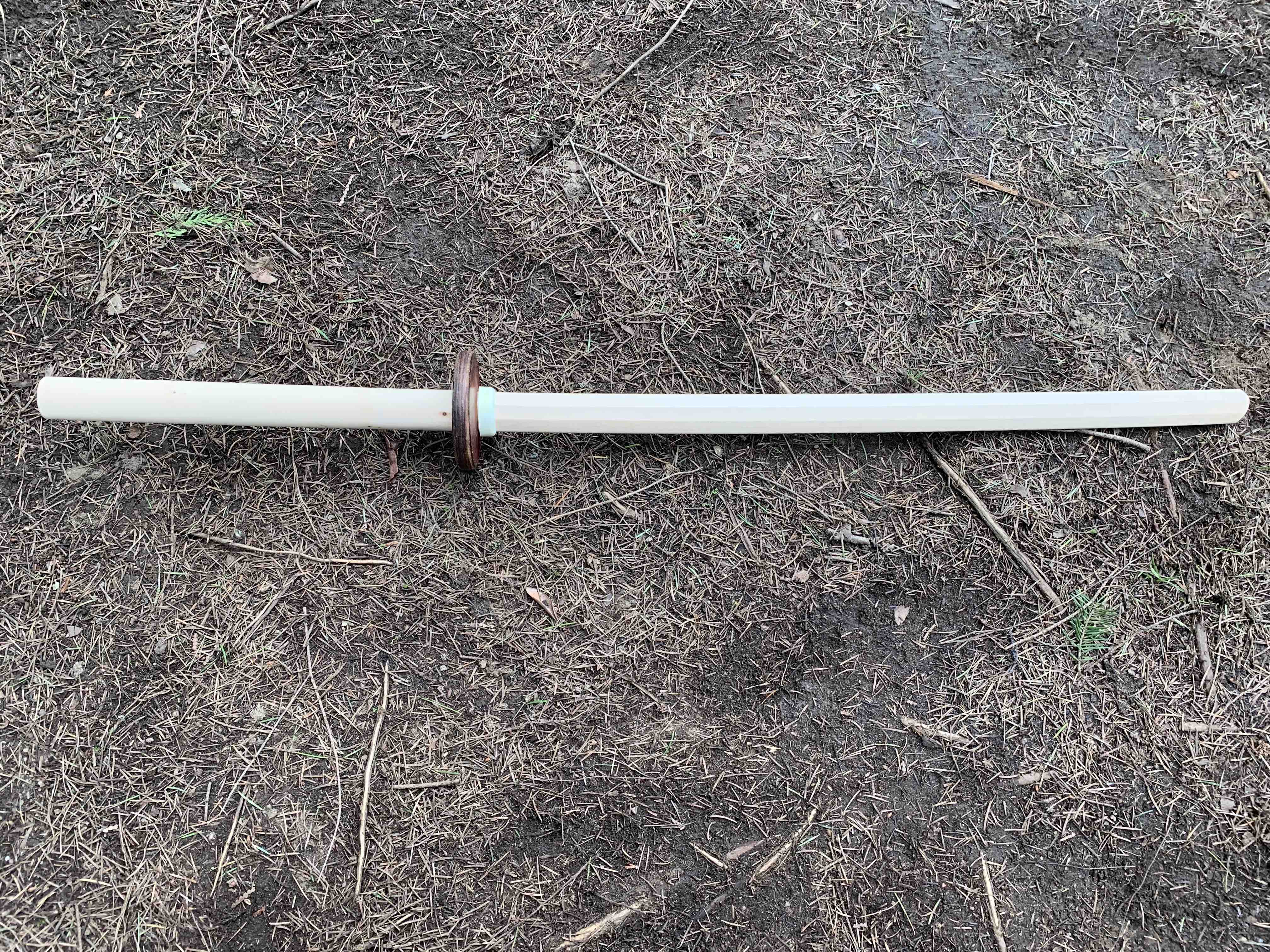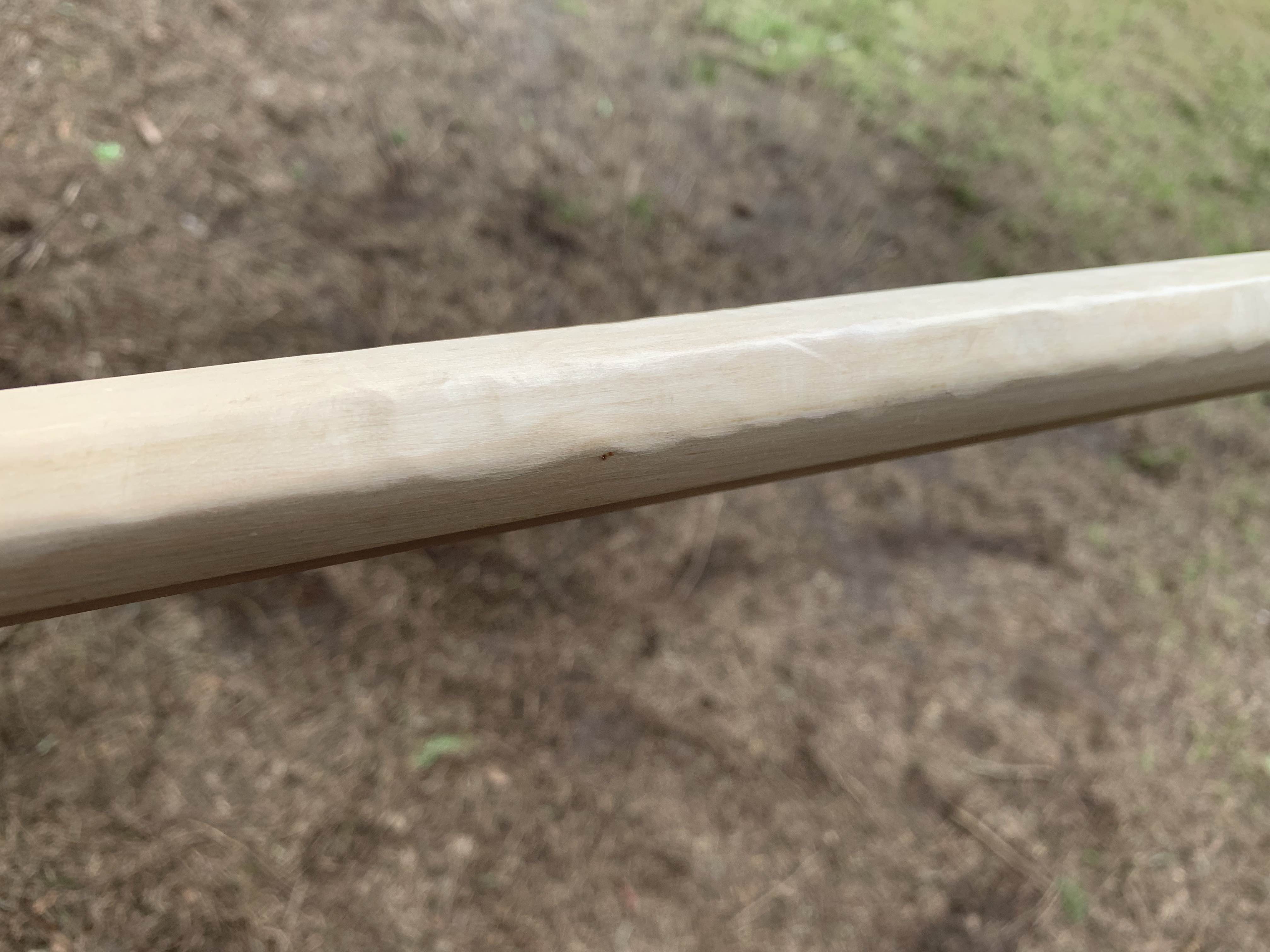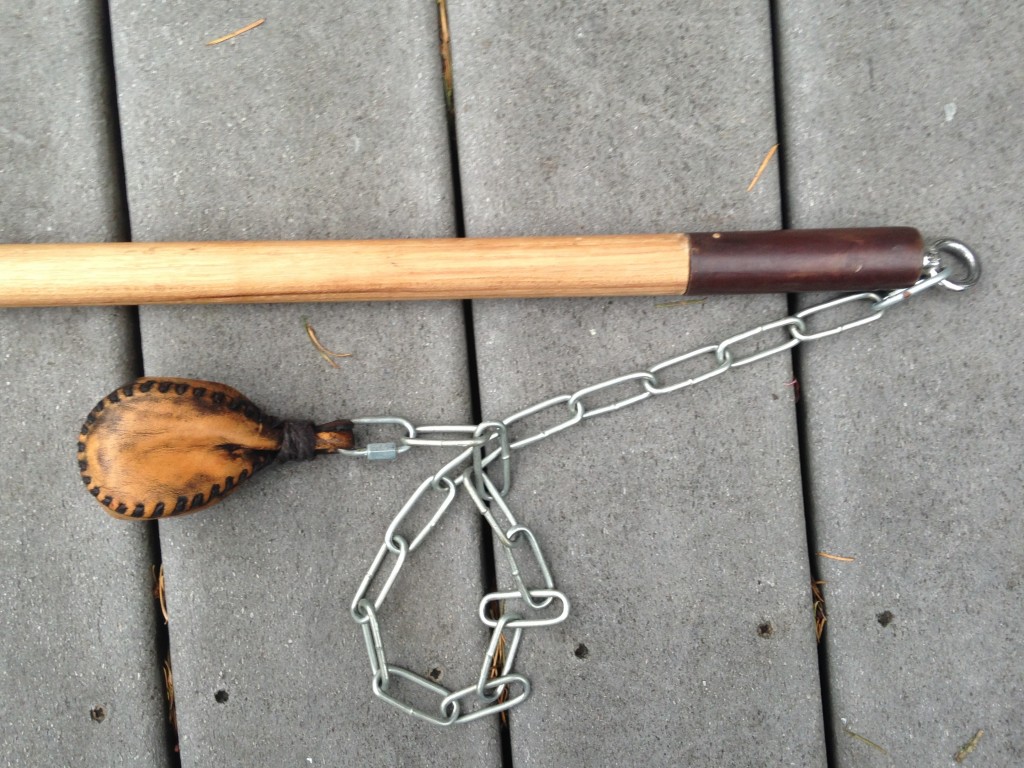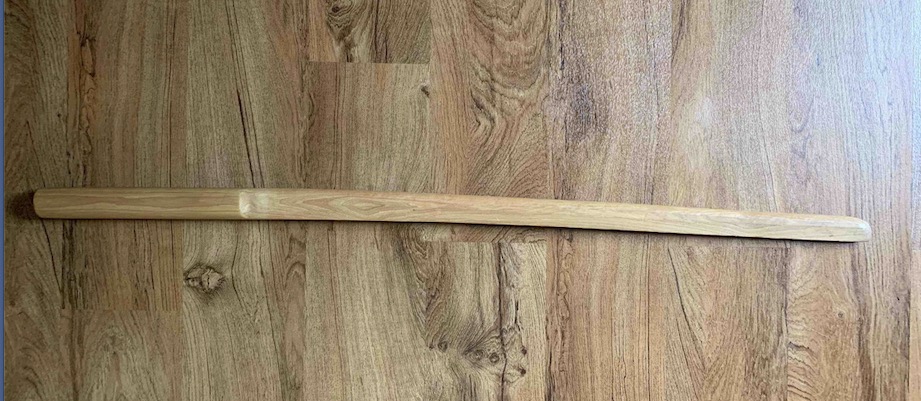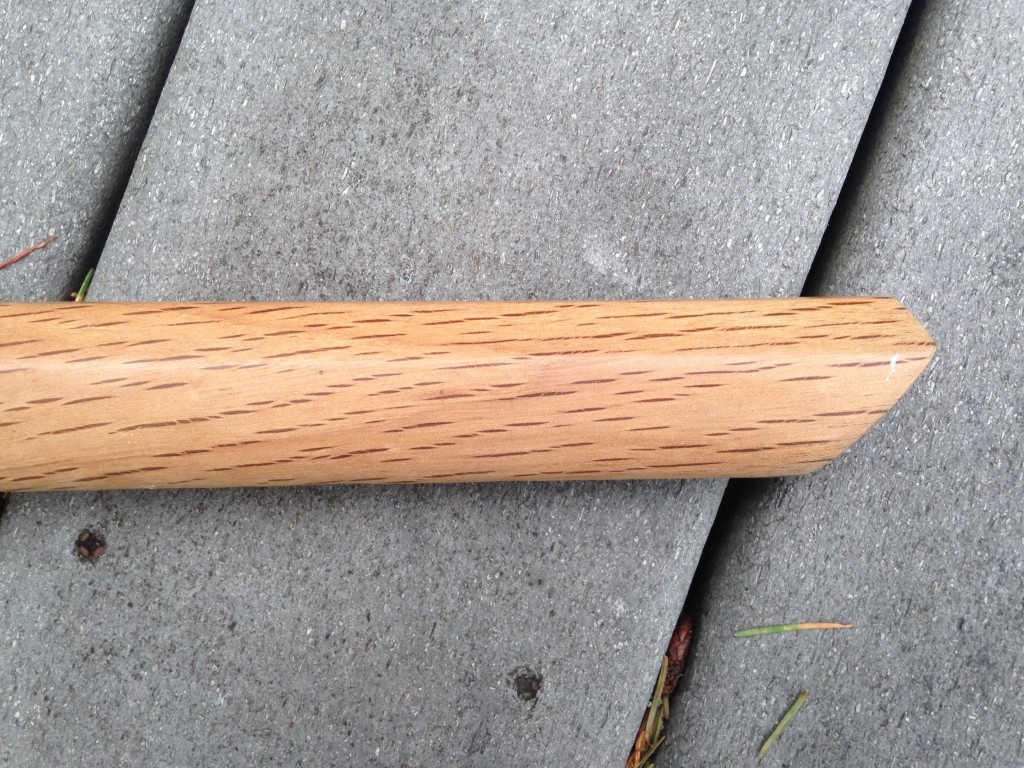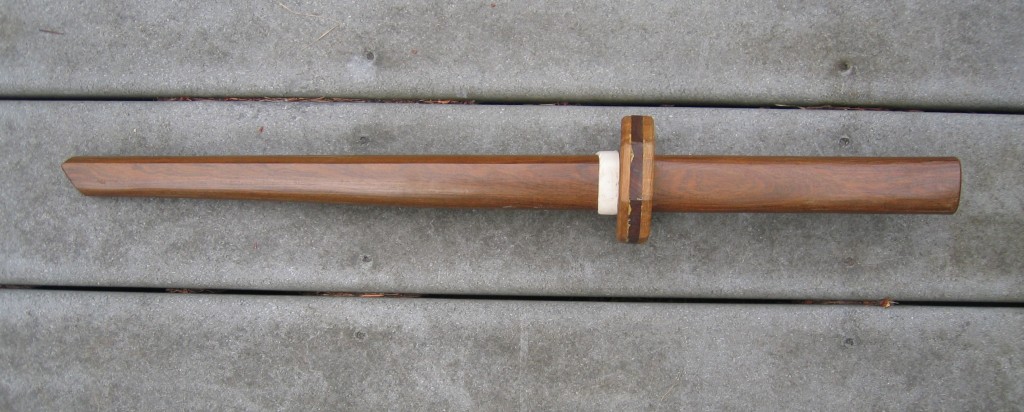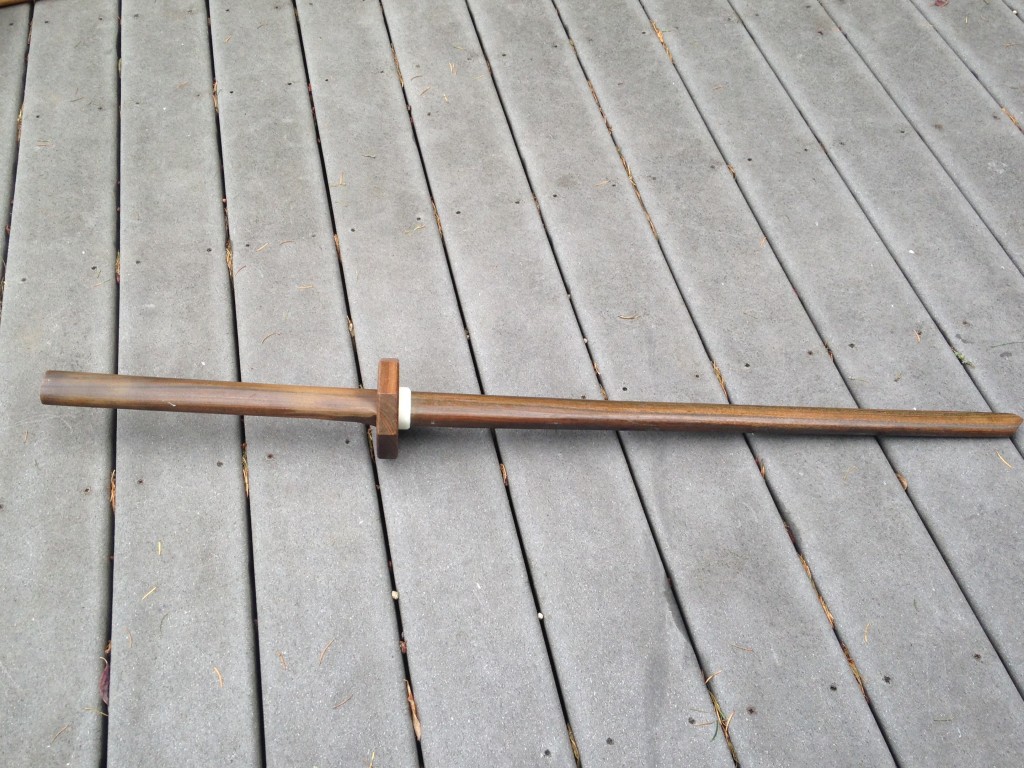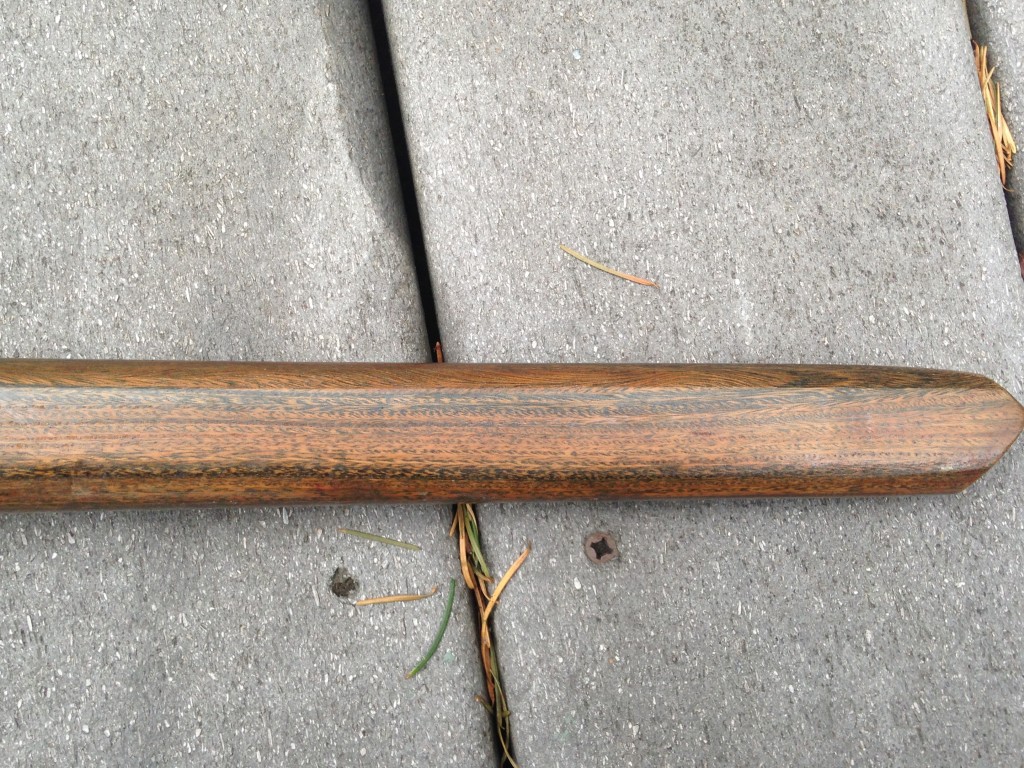![]() NOTE: Wood weapons must have roughly similar qualities to train, one against the other. For example, using a black locust bokuto against a verawood bokuto would be foolish.
NOTE: Wood weapons must have roughly similar qualities to train, one against the other. For example, using a black locust bokuto against a verawood bokuto would be foolish.
Black Locust (False acacia) – common in the Eastern United States, considered an invasive species in parts of Europe. It is common in the Netherlands. It is very rot-resistant. It is one of the hardest woods in North America, but it is prone to splitting and has frequent knots. When harvested young, these problems are minimized. It can be a remarkably attractive wood, with green and yellow coloration. It is used a lot in boat building. One commentator wrote: “The physical properties of black locust are nearly identical to purpleheart. The properties of black locust and osage orange are similar to hickory, except that hickory isn’t very stable (shrinks and swells a lot with moisture).” It is hard to get lumber from the black locust tree, due to a very gnarly grain, knots, and open cavities in the wood. Therefore, it is imperative to get fine/straight-grained wood. Warning: The bark is poisonous, so debark before milling.
I’ve used a black locust naginata. It is alive (more so than jotoba) and quite tough. Feels similar to kashi when struck, but it is although it looks nothing like it. The weapon had dents from very hard usage, but no splintering. It is light in weight, like hickory – perhaps even lighter.
Another informant states: “I decided to try the “Bokken Bashing” method, and take a cutoff scrap to a very large, very old tree in my backyard. It was a draw – only minor denting, and no cracks – and this was only a cutoff, roughly the length of a bokken (and much thinner at the tip).” ALSO “I let one of the yudansha go to town on a reject bokuto of black locust. He’s probably the hardest striker in the dojo, and his impact hickory bokken put a couple light dents into it while actively trying to break it. It’s actually impressive, given how light the wood feels, particularly compared to jatoba.”
On the other hand, I received this report from a practitioner of Kashima Shin-ryu, a system that has very powerful strikes of weapon upon weapon, among the most powerful I’ve ever seen in any ryu. “For our incredibly heavy impact it is just not strong enough: it dents, then splinters. In normal use a bokuto would last me ¾ months, against a good kashi bokuto.”
- Bending strength – 18,761 psi
- Maximum Crushing strength – 9259 psi
- Shearing strength – 2282 psi
- Static bending – 7840 psi
- Work to Maximum Load – 15 in-lbs./in3
- Janka hardness – 1560 – 1700
Cornelian Cherry – (Cornus mas) – This is the legendary wood of Europe’s heroes, of the sarissa spears of the Greeks, and and both javelins and bows. Later, it was used for walking sticks for shepherds and townsmen both. It is a wood heavy enough to float just beneath the surface of water, “like an iceberg,” as one informant has told me, yet flexible enough for spears and bows? Compare it to Dogwood (cornus florida) and you will see remarkably fine numbers. It is a beautiful wood, looking, at least when new, like aged ivory. It takes a high polish and is remarkably smooth. Paradoxically, although the hands can slide easily up and down the shaft (ideal for polearms), it is not ‘slippery,’ so one loses one’s “place”on the weapon, or has it slip out of your hands.
It has a remarkable heft: slightly heavier than Japanese oak, it has an alive feel (in contrast to the dull feeling of ipe, for example). When the weapon is struck, there is considerable vibration near the point of contact, but paradoxically, that shock is not transferred into the hands.
It reminds me, in many ways, of hornbeam, though all of its numbers regarding strength and flexibility are superior. According to the numbers, it is superior in every parameter to hickory, and in fact, feels remarkably different in the hands. However, with fairly hard impact, the hickory bokken I use is absolutely unmarked, whereas the Cornus Mas dents. The dents, so far, do not break at the edges. The bokken, though, did quickly become ‘dimpled.’ I will have to see if, over time, the weapon feathers into splinters, or is otherwise weakened by the denting. It is clear, however, that it is remarkably resistant to shock, with high impact strength, good vibration damping and stiff in a very good way. HERE is article with a lot of details regarding the science concerning cornelian cherry.
The fire-hardened cornus mas bokken does not dent. It is a wonderful practice weapon, among the best I’ve ever held. It has an almost silken feel to it, and almost no shock is transferred to the hands.
As far as my experience, this weapon feels better in the hands, both in cutting and impact, than any other weapon I have ever used.
- Maximum Crushing strength – 10,369 psi
- Janka hardness – 2822 – 3902
- Specific gravity (dry): 0.95- 1.04 g / cm3
Carob (Ceratonia siliqua) – Carob is a small hardwood tree, up to about fifteen meters in height, mostly found in the countries bordering the Mediterranean. Carob is mostly cultivated for its pods, which are used to make edibles, similar to chocolate. Because of its value in this regard (and it is one of the longest lived trees in the world), it is rarely turned into lumber. The wood can be beautiful, ranging in color from a creamy white with streaks and figures of beautiful pink, brown and dark red. One of my students took a thick limb, pruned from a family tree, dried it for about six months with the cut ends sealed to minimize cracking and carved it into a bokken. It is one of the most unique and enjoyable wood weapons I’ve ever used. The wood is relatively light in weight, but dense and very fibrous. It dents very slightly with hard impact, but does not feather into splinters. It absorbs impact as well as any weapon I’ve ever used. I do not know how it would stand up as a long weapon (or how likely it would be to acquire a long straight length to find out), but this is a wonderful wood for bokken, quite different in feel (in a positive way) from anything else I’ve ever used.
Hickory – In America, weapons-grade hickory is very hard to come by, as the best is bought up by tool-handle makers. Kingfisher Woodworks specializes in weapons of this wood, because among American woods, it is the best in terms of a combination of high bending strength, stiffness, hardness, and resistance to shock. Most important, it resists suddenly applied loads very well. I have a number of hickory bo and bokuto. It is an excellent wood – there is no doubt about it, and has one of the best combinations of qualities of any easily available wood. Interestingly, the toughest hickory wood is produced by fast grown, wide-ringed trees. The grain tends to lift a little bit, and it, thus, has a rough feel in the hands. Unlike kashi, which tends to get brittle with age (this can, however, be staved off with proper oiling), hickory will maintain it’s flexibility and strength far longer. I have not liked the hickory weapons that I’ve personally handled, however. It is relatively light – I prefer a heavier weight.
- Bending strength – 16,464 psi
- Maximum Crushing strength – 7379 psi
- Shearing strength – 1215 psi
- Static bending – 7840 psi
- Work to Maximum Load – 19-20 in-lbs./in3
- Janka Hardness Scale – 1820-2460 (NOTE: Hickory has quite a range).
Hornbeam (water beech, ironwood, blue-beech) – A fine wood, with a beautiful creamy color. One of the many woods called “ironwood.” It is difficult to work. I’ve used one bokken made of European hornbeam (Carpinus betulus). It feels great in the hands – medium heavy, and among the most “alive” woods I’ve ever used. It is definitely hard, takes sheering forces well, and is almost exemplary for practice weapons. However, it does dent with hard impact. The dents are not deep and do not feather, but this is a negative quality.
European Hornbeam (Carpinus Betulus)
- Bending strength – 18,011 psi
- Maximum Crushing strength – 7320 psi
- Shearing strength – 2204 psi
- Static bending – 7840 psi
- Toughness – 311 in-lbs.
- Work to Maximum Load – 17 in-lbs./in3
- Janka Hardness Scale 1632
Jotoba (also known as “Brazilian Cherrywood – Hymenaea courbaril) – another beautiful wood, the color ranges from brown, to a rich orange-red. It is quite hard and flexible. It is not as dent resistant as kashi, (but more so than either hornbeam or white sirus), but does make quite strong weapons. Associates of mine what been using it for large naginata, and with the exception of the denting on powerful impact, they hold up well. When well oiled, they become more dent resistant. Caution: Only use the heartwood – the sapwood is far less durable.
- Bending strength – 22,510 psi
- Maximum Crushing strength – 11,780 psi
- Shearing strength – 2543 psi
- Static bending – 11,662 psi
- Toughness – 225 in-lbs.
- Work to Maximum Load – 16 in-lbs./in3
- Janka Hardness Scale 2690
Kashi (shirogashi, akagashi) – Japanese evergreen oak is the standard for Japanese weaponry. This may be an accident, but the Japanese archipelago just happened to have a wood ideal for practice weapons. It is flexible, rather stiff, impact resistant and impact absorbing, resistant to sheering force and to denting. It is less flexible than hickory and more dent resistant. One negative quality is that the sap tends to dry out. You must regularly oil kashi or it gets increasingly brittle. In addition, as it ages, the grain tends to separate. Genuine kashi from Japan is marvelous for weapons.
There is some variation between the now rare kashi grown on the main island of Honshu and that which is more common grown on Kyushu. Honshu, with its more severe and varied weather, produces wood that is somewhat denser, whereas Kyushu kashi is somewhat lighter. The Honshu would, being denser, is more resistent to denting whereas, according to one of the master craftsmen in Japan, Kyushu kashi, being lighter, is more flexible with straighter fibers.
It has been my observation that the quality of wood in Japanese weaponry using kashi has deteriorated for some time. Genuine red oak is very rare. According to Seido’s Jordy Delage, shirogashi (white oak) made weaponry, using Japanese oak in Japan, are made by four craftsmen.
A number of Japanese weapons fabricators are using Taiwanese or mainland Chinese (particularly Manchurian) kashi – it is both more brittle and lighter. I have fabricated some weapons from Japanese oak (I found a supplier of planks in Nerima ward in Tokyo) – beautiful shirogashi. This was thirty-five years ago, however, and I do not know if it still is extant.
Per one of my informants reports that Chinese also favored kashi for both spear shafts and staves, specifically Quercus glauca, which they referred to as Blue Oak (chou 椆 ). A number of other businesses selling Japanese-style weaponry are using wood from China or Taiwan, and it is my observation that the wood is lighter, more porous and brittle – it does not have the singular qualities that make Japanese evergreen oak such a marvelous wood. This is less a problem when one can walk into a shop and handle the practice weaponry directly – it is more problematic when one must order at a distance.
All kashi (Japanese oak) are from the same sub-genus – Cyclobanlanopsis. All are evergreen oaks. There is another common Japanese oak, nara, (quercus glandulifera, sub-gen. lepidobalanus or quercus Mongolica) that is not suitable for weaponry, although it does make fine furniture. I am going in such detail for two reasons: I’m aware of some makers of Japanese weaponry who have confused the two woods, and are either making weapons out of nara – which the Japanese never did – or dismissing Japanese oak based on using the wrong wood. I have listed the species of kashi below. Kashi has been transplanted to Europe and America for almost 150 years. It is very possible that there are local supplies of the wood outside Japan, unrecognized. Furthermore, if one takes the long view, knowing the species, someone (hint) may acquire some trees and grow one’s own – locally. Finally, knowing the sub-genus, you may be able to find other species in your locale with the same properties as the Japanese Cyclobalanopsis.
Sub-genus Cyclobalanopsis
- Akagashi – Quercus acuta
- Arakashi – Quercus glauca
- Hanagagashi – Quercus hondai
- Ichiigashi – Quercus gilva
- Shirakashi – Quercus myrsinaefolia
- Tsukubanegashi – Quercus paucidentata
- Urajirogashi – Quercus stenophylla
Lignum Vitae – This is the hardest wood in the world. Only the heartwood is suitable for weapons – the sapwood is brittle. I have never used this wood for naginata. My lignum bokuto have a beautiful variegated color of browns and chocolate. It is “self-lubricating,” with a waxy resin inside the fibers that keeps it very strong. It was once used for bearings when a metal bearing burned out in a ship’s engine. The grain has a natural lamination, in which it reverses in 1/4-inch strips, with a herringbone pattern of internal lines. It is wonderful for impact – it absorbs a tremendous amount of shock that is not transferred to the hands. It does sometimes “check” – what this means is that the lengthwise “strips” of grain that I mentioned, separate, particularly in dry or variable environments. I’ve not seen this in the consistently moist Pacific Northwest. It is quite heavy – in fact, it doesn’t float. It has a wonderful warm smell. Lignum from the “Caribbean Rim” (Northern South America, Florida and the Islands is an endangered species and thus, not only is it hard to find in any length, but unless you can get some proof that it is old wood, cut before this endangered status, you are participating in the destruction of a species that should be preserved. Reportedly, Argentinean lignum vitae, almost identical in properties, is still relatively common, and is allegedly being well managed in Argentina. At any rate, the properties of verawood are so close that there is no need to get lignum weapons, unless you are lucky enough to find old wood – salvaged or laid away in storage before it was placed on a protected list or a legitimate source from Argentina.
- Maximum Crushing strength – 11,172 psi
- Toughness – 162 in-lbs.
- Janka Hardness Scale – 4200 -4500
Pyinkado (Xylia dolabriformis) – this is a very strong, very dense and hard wood from Southeast Asia. The Katori Shinto-ryu group of Vietnam has been making weapons with this wood and speaks very highly of it. The wood is sometimes referred to as “Burmese Ironwood.”
- Janka Hardness Scale – 2600
Verawood (Palo Santo) – This is sometimes called lignum vera, or greenheart (there is a specific wood by the latter name). Vera wood has qualities very much like lignum vitae, but it is not endangered. The feel is a little different – you can feel the grain in your hands a little more. It, too, absorbs force wonderfully. The wood is dangerous to work – the dust is corrosive to the skin. I do not know if this is a genuine acid/base or poison, or if it makes an allergic dermatitus. It cannot be worked without protection – both for your skin and your lungs. The sap, too, has a peculiar smell – it is hard to describe, but it causes an allergic reaction among many. Therefore, I’ve had all my weapons coated with Varethane. The wood starts with an olive color and gets progressively darker. I’ve had bokuto, nagamaki and bo by this weapon. The bo finally broke. The break was at about a 45 degree angle -it did not splinter. One thing about vera – it makes a very flexible bo. With kashi, for example, I could cut full-force and stop the weapon one millimeter from the body of the opponent. With my verawood bo, I had to have about 10 centimeters distance, because it whips! This is a wonderful trait for a bo, but without care, you can really injure your partner. I would love to make a spear out of verawood. Admittedly, it is quite heavy, but it is possible that it would make an ideal spear, with both whip and a lot of strength. Janka Hardness Scale – 4000 – 4500


